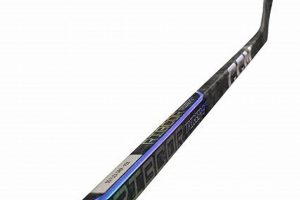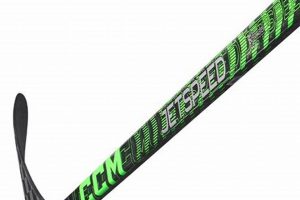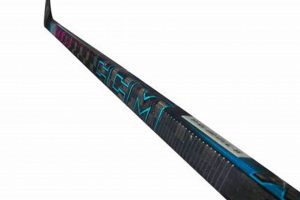Selection of the appropriate hockey stick is a critical consideration for defensive players. The optimal stick enhances performance in key areas such as puck control, shot accuracy, and defensive zone clearances. For example, a stick with a higher flex rating may be preferred by a defenseman focused on powerful slapshots from the point, while a lower flex could benefit those prioritizing quick wrist shots and passes in tighter spaces.
The right equipment choice influences a player’s effectiveness and contributes to overall team success. Historically, wooden sticks were standard, but advancements in composite materials have led to lighter, more durable, and customizable options. These advancements provide defensive players with tools tailored to their specific playing style and physical attributes, impacting their ability to defend effectively and contribute offensively.
Therefore, a thorough examination of various stick characteristics, including flex, curve, lie, and material composition, is necessary when determining the most suitable option. Further discussion will delve into these specific factors to aid in informed equipment selection for defensive hockey players.
Selection Guidance
The following recommendations offer guidance on selecting a hockey stick optimized for the defensive role. These points emphasize performance attributes and material considerations to assist in equipment evaluation.
Tip 1: Flex Selection: A higher flex rating generally supports powerful shots from the blue line, providing increased energy transfer. Experiment with flex ranges to identify the optimal balance between power and control based on individual strength and shooting technique.
Tip 2: Curve Profile: A more closed face curve facilitates quicker puck release and improved accuracy for passing and clearing the defensive zone. Evaluate different curve depths to find a profile aligned with puck handling preferences.
Tip 3: Lie Angle: Correct lie angle ensures the blade sits flush on the ice surface, maximizing puck control during skating and shooting. Observe how the blade interacts with the ice during drills to determine appropriate lie.
Tip 4: Stick Length: A stick that extends to approximately the chin when standing on skates typically provides adequate reach and leverage for defensive plays. Adjust length slightly based on skating stance and reach requirements.
Tip 5: Material Composition: Composite sticks offer enhanced durability and responsiveness compared to traditional wood. Explore various composite blends to identify the optimal balance between weight, feel, and durability based on playing style.
Tip 6: Grip Texture: Consistent grip is crucial for maintaining control during intense gameplay. Evaluate different grip textures to identify a comfortable and secure feel that minimizes slippage.
Tip 7: Kick Point Considerations: A low kick point can facilitate quick release shots, advantageous for deflections and scoring opportunities near the net. Consider the balance between shot power and release speed when evaluating kick point options.
Implementing these recommendations supports a more informed equipment selection process, aligning stick characteristics with the specific demands of the defensive position.
The subsequent sections will explore real-world examples and case studies, further illustrating the impact of equipment choices on defensive performance.
1. Flex Rating
Flex rating, an expression of a stick’s stiffness, significantly influences a defenseman’s shooting power and puck control. A lower flex rating denotes a more flexible stick, requiring less force to bend. Conversely, a higher flex rating indicates a stiffer stick, demanding greater force for deflection. For defensemen, the relationship between flex and performance is particularly critical due to the diverse range of actions they undertake, from clearing the puck to initiating offensive plays.
The importance of flex manifests in various game situations. For example, a defenseman tasked with consistently delivering powerful slapshots from the point might benefit from a higher flex rating. The added stiffness facilitates efficient energy transfer, maximizing shot velocity. Conversely, a defenseman who specializes in quick, deceptive wrist shots or prefers agile puck handling in the defensive zone may find a lower flex rating more advantageous. The increased flexibility allows for easier loading of the stick and a quicker release, even with less applied force. Determining the appropriate flex involves careful consideration of individual strength, shooting style, and preferred defensive tactics.
In conclusion, flex rating is a key determinant in identifying a suitable hockey stick for a defenseman. Incorrect flex selection may result in compromised shooting power, reduced puck control, and ultimately, diminished effectiveness on the ice. Prioritizing flex as a primary evaluation criterion and aligning it with individual player characteristics ensures optimal performance and facilitates successful execution of defensive and offensive responsibilities.
2. Curve Type
The blade curve on a hockey stick directly influences puck control, shot trajectory, and overall playmaking ability, rendering it a crucial component in selecting the most suitable equipment for a defenseman. Different curve types cater to various playing styles and strategic roles. A deeper curve, characterized by a more pronounced bend in the blade, tends to facilitate elevated shot trajectories, proving beneficial for clearing the puck over opposing players or generating rebounds in front of the net. Conversely, a shallower curve often enhances puck handling and passing accuracy, enabling crisp outlet passes and controlled zone exits. The specific curve type affects a defenseman’s ability to execute fundamental tasks, impacting both defensive containment and offensive contribution.
Consider a defenseman primarily responsible for breaking up plays and initiating counterattacks. This player might benefit from a curve that offers a balance between puck control and quick release. A moderate mid-curve, for instance, could enable precise passing while still providing adequate lift for clearing attempts. Conversely, a defenseman tasked with primarily defending the net front and blocking shots may opt for a flatter curve to maximize puck control in tight spaces and minimize unwanted deflections. Examining NHL defenseman’s stick preferences reveals a diversity of curve types, each tailored to individual strengths and tactical deployment, further emphasizing the importance of this selection.
In summary, the curve type is a critical determinant in optimizing a hockey stick for a defenseman’s specific responsibilities. Choosing a curve that complements individual playing style and strategic role contributes significantly to enhancing puck control, shot accuracy, and overall effectiveness on the ice. Failure to adequately consider curve characteristics can limit a defenseman’s capabilities, highlighting the necessity of careful evaluation and personalized equipment selection.
3. Lie Angle
Lie angle, the angle between the blade and the shaft of a hockey stick when the blade’s bottom edge rests on a flat surface, significantly impacts a defenseman’s puck-handling ability and shooting accuracy. An inappropriate lie angle can compromise a defenseman’s ability to maintain a flat blade on the ice, leading to inconsistent puck reception and inaccurate shots. For instance, a lie angle that is too upright causes the heel of the blade to lift off the ice, resulting in the puck rolling off the toe during stickhandling or shooting. Conversely, a lie angle that is too flat causes the toe of the blade to lift, similarly impacting puck control and shot direction. Consequently, the correct lie angle is an indispensable component of an optimal hockey stick selection for a defenseman, affecting both fundamental skill execution and overall performance.
The appropriate lie angle is determined by a defenseman’s skating stance and stick-handling technique. A taller defenseman, who typically adopts a more upright skating posture, may require a higher lie angle to ensure the blade sits flush on the ice. Conversely, a shorter player with a lower, more aggressive stance might benefit from a lower lie angle. The effect of lie angle is particularly evident during passing scenarios. A defenseman attempting a crisp outlet pass with an incorrect lie angle may experience difficulty keeping the puck on the blade, resulting in a weak or inaccurate pass that can disrupt the transition game. Adjusting the lie angle to match individual skating mechanics promotes efficient puck control and precise execution of passing and shooting techniques, crucial for both defensive and offensive contributions.
In summary, the lie angle is a critical, yet often overlooked, element in selecting a hockey stick that complements a defenseman’s individual playing style and physical characteristics. Understanding the relationship between lie angle, skating stance, and stick-handling technique is essential for maximizing puck control, shot accuracy, and overall effectiveness on the ice. Therefore, diligent attention to lie angle selection is a necessary aspect of optimizing a defenseman’s equipment to facilitate enhanced performance and strategic contributions to the team.
4. Stick Length
Stick length represents a fundamental consideration in selecting optimal equipment for a defenseman, directly influencing reach, puck control, and defensive effectiveness. Selecting an appropriate stick length necessitates careful evaluation to align with individual skating style and defensive responsibilities.
- Reach and Defensive Coverage
A longer stick extends a defenseman’s reach, enabling them to disrupt passing lanes, intercept pucks, and apply pressure on opposing players from a greater distance. Extended reach can prove particularly advantageous when defending against skilled forwards attempting to gain zone entry or create scoring opportunities near the net. However, excessive length may impede close-quarters puck handling and agility.
- Puck Control and Agility
Shorter sticks generally enhance puck control and maneuverability, allowing for quicker movements and tighter turns. A defenseman prioritizing agile puck handling and rapid defensive adjustments may benefit from a slightly shorter stick. This configuration promotes swift transitions and facilitates efficient puck retrieval in congested areas of the defensive zone.
- Shooting and Passing Accuracy
Stick length influences shooting and passing accuracy. A stick of appropriate length promotes a more natural shooting motion and allows for better leverage during passing. Conversely, an improperly sized stick can lead to inconsistent shot trajectories and inaccurate passes, potentially hindering offensive contributions from the blue line. Balance between reach and control is critical for optimizing both defensive containment and offensive initiation.
- Body Size and Stance
The optimal stick length is intrinsically linked to a player’s height and skating stance. A common guideline suggests the stick should extend to the player’s chin when standing on skates. However, individual preferences and skating styles often necessitate adjustments. Defensemen with a more upright stance may prefer a longer stick to maximize reach, while those with a lower, more aggressive stance might opt for a slightly shorter stick to enhance mobility.
Therefore, stick length is a critical parameter influencing a defenseman’s overall effectiveness. The appropriate stick length facilitates a balance between reach, puck control, shooting accuracy, and mobility, contributing significantly to enhanced defensive performance. Careful consideration of these factors ensures the selection of a stick that aligns with individual playing style and physical attributes, ultimately optimizing performance on the ice.
5. Material Composition
Material composition directly influences the performance characteristics of a hockey stick, rendering it a critical consideration in selecting equipment suitable for a defenseman. The evolution from traditional wooden sticks to composite materials has significantly altered stick properties, impacting weight, durability, and responsiveness. Understanding the interplay between different materials and their effect on stick performance is essential for making informed equipment choices.
- Weight and Balance
Composite materials, such as carbon fiber and fiberglass, allow for the creation of lighter sticks compared to traditional wood. Reduced weight enhances stick handling speed and reduces fatigue during prolonged gameplay. Balance point, influenced by material distribution, affects the stick’s feel and swing weight. A well-balanced stick facilitates quicker reactions and smoother puck movement, contributing to enhanced defensive agility. Example: A carbon fiber stick with a high balance point may be favored by defensemen who prioritize quick puck transitions.
- Durability and Impact Resistance
The durability of a hockey stick is directly linked to its material composition. Composite sticks offer superior resistance to cracking and breaking compared to wooden counterparts. Reinforced areas, often incorporating Kevlar or other high-strength fibers, enhance impact resistance in key stress zones. Example: A stick with a carbon fiber and Kevlar blend is more likely to withstand repeated blocking of shots, a critical requirement for defensemen.
- Flex and Energy Transfer
The material composition dictates the stick’s flex characteristics and its ability to transfer energy during shooting. Carbon fiber offers excellent stiffness-to-weight ratio, enabling efficient energy transfer and enhanced shot power. Different carbon fiber weaves and layups can be used to fine-tune the stick’s flex profile, influencing shot velocity and release speed. Example: A stick with a unidirectional carbon fiber layup may provide a stiffer flex, ideal for defensemen seeking powerful slapshots.
- Feel and Responsiveness
Material composition affects the stick’s feel and responsiveness, influencing puck control and feedback. Softer materials, such as fiberglass, can dampen vibrations and provide a more comfortable feel, while stiffer materials offer enhanced responsiveness and puck awareness. Example: A stick with a blend of carbon fiber and fiberglass may offer a balance between responsiveness and vibration dampening, suitable for defensemen who prioritize precise puck handling.
In conclusion, the selection of materials in hockey stick construction plays a pivotal role in determining its performance attributes. By carefully considering factors such as weight, durability, flex, and feel, defensemen can choose sticks that optimize their on-ice effectiveness. Advancements in composite materials have provided a range of options tailored to diverse playing styles and preferences, enabling informed equipment selection based on individual needs and tactical requirements.
6. Kick Point
Kick point, or flex point, signifies the area on a hockey stick shaft that bends most significantly when force is applied during a shot. This location directly influences shot characteristics, affecting both release speed and shot power. For a defenseman, the kick point’s impact on performance is multifaceted, contingent upon individual playing style and tactical responsibilities. A lower kick point, positioned closer to the blade, facilitates a quicker release, advantageous for snapshots and deflections executed in close proximity to the net. A higher kick point, located nearer the handle, typically generates increased power on slapshots from the blue line. The selection of an appropriate kick point thus requires careful consideration of a defenseman’s role within the team’s offensive strategy and their individual shooting preferences.
The effect of kick point on defensive play extends beyond direct shot generation. For instance, a defenseman frequently tasked with clearing the defensive zone under pressure may benefit from a mid-kick point, providing a balance between shot velocity and puck control. This configuration allows for both efficient clearing attempts and accurate passing to teammates. Conversely, a defenseman primarily responsible for generating offensive opportunities from the blue line might find a higher kick point more effective, enabling powerful slapshots that create rebounds or directly score goals. The choice of kick point should also align with the defenseman’s shooting technique; those who rely on a quick wrist shot may find a low kick point more responsive, while players who prefer to load up for a slapshot may benefit from the increased energy transfer of a high kick point. Examples of different stick models favored by NHL defensemen often illustrate this principle, with certain models designed for specific shooting profiles and tactical deployments.
In summary, the kick point is a critical determinant in optimizing a hockey stick for a defenseman’s specific requirements. Understanding the relationship between kick point location, shot characteristics, and individual playing style allows for a more informed equipment selection process. The challenge lies in balancing the need for quick release shots with the potential for generating powerful slapshots, requiring careful evaluation and personalized fitting to maximize on-ice performance. Ultimately, the optimal kick point complements a defenseman’s strengths, enabling them to excel in both defensive containment and offensive contribution.
Frequently Asked Questions
The following addresses common inquiries regarding optimal hockey stick selection for defensive players, providing clarity on key considerations and dispelling misconceptions.
Question 1: What flex rating is most suitable for a defenseman?
The ideal flex rating is contingent on individual strength, weight, and shooting style. A general guideline suggests a flex rating approximately half the player’s body weight in pounds. Experimentation within a range is recommended to determine optimal energy transfer and control.
Question 2: How does curve type affect defensive play?
Curve type influences puck control, shot trajectory, and passing accuracy. A shallower curve generally enhances puck handling and passing, while a deeper curve can facilitate elevated shots for clearing attempts. Selection should align with individual play style.
Question 3: Is stick length critical for defensive players?
Stick length affects reach, puck control, and defensive coverage. A stick extending to the chin when on skates is a common starting point, but adjustments based on skating stance and preference are necessary.
Question 4: What materials are preferred in hockey sticks for defensemen?
Composite materials, such as carbon fiber, offer superior weight-to-strength ratios compared to wood. These materials enhance durability, responsiveness, and overall performance. Specific blends influence feel, flex, and energy transfer.
Question 5: How does kick point affect a defenseman’s shooting ability?
Kick point influences shot release speed and power. A lower kick point promotes quicker release, advantageous for snapshots, while a higher kick point typically generates increased power on slapshots. Consider the balance between these attributes.
Question 6: Can lie angle impact defensive performance?
Lie angle affects blade contact with the ice, influencing puck control and shot accuracy. The correct lie ensures the blade sits flush, maximizing control during skating and shooting. Observation of blade angle during gameplay is critical for determining appropriate lie.
Optimal hockey stick selection for a defenseman requires careful consideration of flex, curve, length, material, kick point, and lie. Individualization based on player characteristics and playing style is paramount for maximizing on-ice effectiveness.
The subsequent section will present specific stick models frequently recommended for defensive players, incorporating insights from expert reviews and player feedback.
Conclusion
The preceding examination underscores the complex interplay of factors influencing the selection of the best hockey stick for defenseman. Flex, curve, lie, length, material composition, and kick point collectively define a stick’s performance characteristics, impacting a player’s capacity for defensive containment, puck control, and offensive contribution. Optimal equipment selection necessitates a thorough understanding of these variables and their relationship to individual playing style.
Effective utilization of this information demands diligence in equipment evaluation and personalized fitting. Continued advancements in materials and design suggest ongoing refinement of hockey stick technology, offering future opportunities to further optimize equipment for the demands of the defensive position. This proactive approach to equipment selection will maximize on-ice effectiveness and contribute to the overall success of the team.







